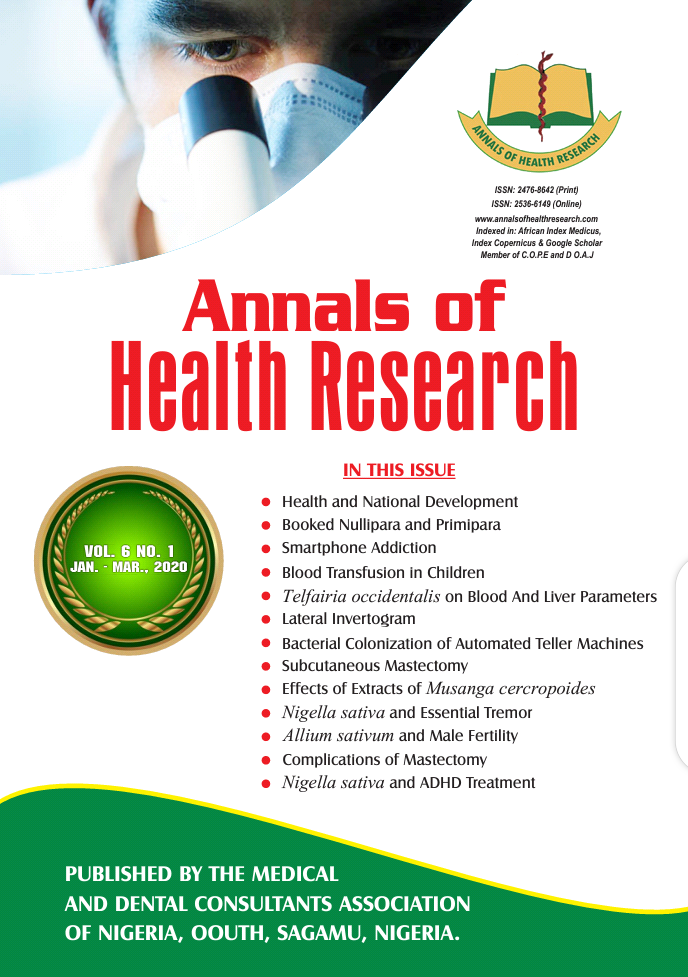Qualitative phytochemical screening and antimicrobial evaluation of the total alkaloids of the hydroalcoholic extracts of the leaves and stem bark of Musanga cercropoides (Urticaceae)
DOI:
https://doi.org/10.30442/ahr.0601-09-69Keywords:
Antimicrobial, Phytochemical screening, Musanga cercropioides, Total alkaloidsAbstract
Background: Musanga cecropioides R.Br. ex Tedlie (Urticaceae) is a plant that is widely used in Nigerian traditional medicine for the treatment of various infections such as cough, diarrhoea, and vaginal candidiasis.
Objective: To study the antimicrobial potency of the total alkaloids of the hydroalcoholic extracts (HAE) of the stem bark (ST) and leaves of Musanga cecropioides.
Method: The antimicrobial activities of the total alkaloidal constituent of the HAE of the ST and leaves were screened using agar diffusion method using Staphylococcus aureus, Bacillus subtils,Klebsiella pneumonia, Escherichia coli, and Candida albicans as test organisms. The preliminary phytochemical screening of the ST and leaves were performed following the conventional standard procedures of Trease and Evans.
Results: Phytochemical screening revealed the presence of alkaloids, phenols, flavonoids, tannins, sterols, saponins and terpenoids. The HAE of both ST and leaves exhibited notable activities against the tested microorganisms at different concentrations (500, 250, 125, 62.5 mg/ml) with zones of inhibition ranging from 8.6±0.5mm to 20.0±1.0mm. The highest activity against bacteria had a zone of inhibition of 18.6±1.1mm and 20.0±1.0mm for fungus. The zone of inhibition for antibacterial control drug (Ciprofloxacin) was 42.3±2.0mm while that of antifungal control drug (Griseofulvin) was 32.0±0.8mm. The total alkaloid yield for the ST was 1.200%w/w and 1.332%w/w for the leaves.
Conclusion: Musanga cercropoidesmay be a valuable source of a therapeutic agent for potent clinical antimicrobials.
References
Okenwa UI, Donatus EO. Phytochemical composition and anti-inflammatory activities of Brachystegiaeurycoma seeds and stem bark. Der Pharma Chemica 2013; 5(1): 224-228.
Boberek JM, Stach J, Good L. Genetic evidence for inhibition of bacterial division protein FtsZ by berberine. Adv Phytochem Res 2010; e135745.
Casu L, Cottiglia F, Leonti M, De Logu A, Agus E, Tse-Dinh YCB. Ungeremine effectively targets mammalian as well as bacterial type I and type II topoisomerases. Med Chem Lett 2011; 21: 7041-7044.
Senjobi CT, Ettu AO, Gbile ZO. Pharmacological screening of Nigerian species of M. cecropioides R. Br. Ex Teddie (Moraceae) in rodents as antihypertensive. Afr J Plant Sci 2012; 6: 232–238.
Uwah AF, Otitoju O, Ndem JI, Peter AI. Chemical composition and antimicrobial activities of adventitious root sap of Musanga cecropioides. Pharm Lett 2013; 5: 13–16.
Da Rocha CQ, Vilela FC, Cavalcante GP, Santa-cecilia FV, Santos-e-Silva L, dos Santos MH, et al. Anti-inflammatory and anti-nociceptive effects of Arrabidaeabrachypoda (DC.) Bureau roots. J Ethnopharmacol 2011; 133: 396–401.
Orwa CA, Mutua, Kindt R. Jamnadass R, Anthony S. 2009 AgroforestreeDatabase:a tree reference and selection guide version 4.0 (http://www.worldagroforestry.org/sites/treedbs/treedatabases.asp).
Adeneye AA. Protective activity of the stem bark aqueous extract of Musangacecropioides in carbon tetrachloride- and acetaminophen induced acute hepatotoxicity in rats.Afr J Traditional, Complementary Altern Med; 6(2): 131 – 138.
Samanta A, Das G, Das S. Roles of flavonoids in plants. Int J Pharm Sci Tech 2011; 6: 12–35.
Fomogne FMCY, Van VS, Ndinteh DT, Krause RWM, Olivier DK. Antibacterial activities of plants from Central Africa used traditionally by the Bakola pygmies for treating respiratory and tuberculosis-related symptoms. J Ethnopharmacol 2014; 155: 123-131.
Burkill HM. The Useful Plants of West Tropical Africa. Families A–D. Royal Botanic Gardens, Kew, Richmond, United Kingdom 1985; 1(2): 346-349.
Owolabi OJ, Ayinde BA, Nworgu ZA, Ogbonna OO. Antidiarrheal evaluation of the ethanol extract of Musanga cecropioides stem bark.MethodsFindings Exp Clin Pharmacol2010; 32(6): 407-411.
Ayinde BA, Omogbai EKI,Onwukaeme DN. Hypotensive effects of 3,4-dihydroxybenzyaldehyde isolated from the stem bark of Musanga cecropioides. J Pharmacognosy Phytotherapy 2010; 1(1): 004-009.
Loreto M, Ana M, Alejandro U, Victor F, Andres Q. Antibacterial activity of alkaloid fraction from Berberis microphyllaG. Forst and study of synergism with ampicillin and cephalothin. Institute of Pharmaceutical Education and Research. Shipur.2016. Accessed 21st August 2019.
Agbaje EO, Fageyinbo MS. Evaluating anti-inflammatory activity of aqueous root extract of Strophanthushispidus (DC.) (Apocynaceae). Int J Appl Res Nat Prod 2011; 4: 7–14.
Veeresham C. Natural products derived from plants as a source of drugs. J Adv Pharm Technol Res 2012; 3: 200-201.
Abbas M, Saeed F, Anjum FM, Afzaal M, Tufail T, Bashir MS. Natural polyphenols: an overview. Int J Food Prop 2017; 20: 1689–1699.
Shahat AA, Mahmoud EA, Al-Mishari AA, Alsaid MS. Antimicrobial activities of some Saudi Arabian herbal plants. Afr J Traditional Complementary Altern Med. 2017; 14: 161–165.
Downloads
Published
Issue
Section
License
The articles and other materials published in the Annals of Health Research are protected by the Nigerian Copyright laws. The journal owns the copyright over every article, scientific and intellectual materials published in it. However, the journal grants all authors, users and researchers access to the materials published in the journal with the permission to copy, use and distribute the materials contained therein only for academic, scientific and non-commercial purposes.


